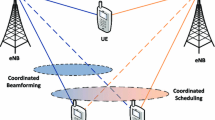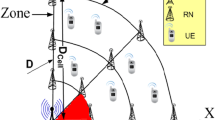Abstract
In very crowded areas, a large number of LTE users contained in a single cell will try to access services at the same time causing high load on the Base Station (BS). Some users may be blocked from getting their requested services due to this high load. Using a two-hop relay architecture can help in increasing the system capacity, increasing coverage area, decreasing energy consumption, and reducing the BS load. Clustering techniques can be used to configure the nodes in such two-layer topology. This paper proposes a new algorithm for relay selection based on the Basic Sequential Algorithmic Scheme (BSAS) along with power control protocol. Unlike other capacity improving techniques such as small cells and relay stations this approach does not require additional infrastructure. Instead, users themselves will act as a temporary relay stations. Modifications are implemented to the original BSAS to make it suitable for LTE environment and to improve its performance. The protocol for resource allocation and power control is implemented assuming a multi cell scenario. The algorithm is compared to other relaying and clustering schemes in addition to the conventional LTE. The simulation results show that the proposed algorithm has improved system capacity and energy consumption compared to other existing clustering/relaying schemes.





Similar content being viewed by others
References
Oguntoyinbo, O. J. (2013). The future of LTE: The Femtocells perspective. Espoo: Aalto University.
Coombs, R., & Steele, R. (1999). Introducing microcells into macrocellular networks: A case study. IEEE Transactions on Communications, 47, 568–576.
Nourizadeh, H., Nourizadeh, S., & Tafazolli, R. (2006). Performance evaluation of cellular networks with mobile and fixed relay station. In 2006 IEEE 64th on vehicular technology conference, 2006. VTC-2006 Fall. (pp. 1–5).
Abbas, O. A. (2008). Comparisons between data clustering algorithms. International Arab Journal of Information Technology, 5, 320–325.
Theodoridis, S., Pikrakis, A., Koutroumbas, K., & Cavouras, D. (2010). Introduction to pattern recognition: A Matlab approach. Cambridge, MA: Academic Press.
Ahmed, I., & Mohamed, A. (2012). On the joint scheduling and intra-cell interference coordination in multi-relay LTE uplink. In 2012 IEEE on Globecom workshops (GC Wkshps) (pp. 111–115).
Evans, R., Pfahringer, B., & Holmes, G. (2011). Clustering for classification. In 2011 7th international conference on information technology in Asia (pp. 1–8).
Davcev, D., & Gómez, J. M. (2010). ICT innovations 2009. Berlin: Springer.
Sasikumar, P., & Khara, S. (2012). K-Means clustering in wireless sensor networks. In 2012 fourth international conference on computational intelligence and communication networks (CICN) (pp. 140–144).
Geon Yong, P., Heeseong, K., Hwi Woon, J., & Hee Yong, Y. (2013). A novel cluster head selection method based on K-means algorithm for energy efficient wireless sensor network. In 2013 27th international conference on advanced information networking and applications workshops (WAINA) (pp. 910–915).
Harb, H., Makhoul, A., Laiymani, D., Jaber, A., & Tawil, R. (2014). K-Means based clustering approach for data aggregation in periodic sensor networks. In 2014 IEEE 10th international conference on wireless and mobile computing, networking and communications (WiMob) (pp. 434–441).
Kumar, G., Mehra, H., Seth, A. R., Radhakrishnan, P., Hemavathi, N., & Sudha, S. (2014). An hybrid clustering algorithm for optimal clusters in wireless sensor networks. In 2014 IEEE students’ conference on electrical, electronics and computer science (SCEECS) (pp. 1–6).
Liansheng, T., Yanlin, G., & Gong, C. (2008). A balanced parallel clustering protocol for wireless sensor networks using K-means techniques. In Second international conference on sensor technologies and applications, 2008. SENSORCOMM ‘08 (pp. 300–305).
Talgini, A., Shakarami, V., Sheikholeslam, F., & Chatraei, A. (2014). Aerial node placement in wireless sensor networks using fuzzy K-means clustering. In 2014 8th international conference on e-commerce in developing countries: With focus on e-trust (ECDC) (pp. 1–7).
Chung-Horng, L., & Chenjuan, Z. (2008). Using hierarchical agglomerative clustering in wireless sensor networks: An energy-efficient and flexible approach. In IEEE on global telecommunications conference, 2008. IEEE GLOBECOM 2008 (pp. 1–5).
Jain, T. K., Saini, D. S., & Bhooshan, S. V. (2014). Performance analysis of hierarchical agglomerative clustering in a wireless sensor network using quantitative data. In 2014 international conference on information systems and computer networks (ISCON) (pp. 99–104).
Murtagh, F. (1983). A survey of recent advances in hierarchical clustering algorithms. The Computer Journal, 26, 354–359.
Tabrizi, H., Farhadi, G., Cioffi, J., & Aldabagh, G. (2014). Coordinated tethering over white spaces. IEEE Transactions on Vehicular Technology, 64(9), 4170–4179.
Tabrizi, H., Farhadi, G., & Cioffi, J. M. (2013). CaSRA: An algorithm for cognitive tethering in dense wireless areas. In 2013 IEEE on global communications conference (GLOBECOM) (pp. 3855–3860).
Al-Haddad, U., Aldabbagh, G., & Dimitriou, N. (2015). Clustering over TV white space in dense wireless areas: Dynamic hotspot selection and resource allocation. Mitteilungen Klosterneuburg, 65, 12.
Hajjar, M., Aldabbagh, G., & Dimitriou, N. (2015). Using clustering techniques to improve capacity of LTE networks. In 2015 21st Asia-Pacific conference on communications (APCC) (pp. 68–73).
Nourizadeh, H., & Tafazolli, R. (2005). Capacity improvement of WCDMA cellular system through different relaying strategies. In International conference on wireless and mobile communication networks.
Sreng, V., Yanikomeroglu, H., & Falconer, D. D. (2003). Relayer selection strategies in cellular networks with peer-to-peer relaying. In 2003 IEEE 58th vehicular technology conference, 2003. VTC 2003-Fall (pp. 1949–1953).
Li-Chun, W., Wen-Shan, S., Jane-Hwa, H., Chen, A., & Chung-Ju, C. (2008). Optimal relay location in multi-hop cellular systems. In IEEE on wireless communications and networking conference, 2008. WCNC 2008 (pp. 1306–1310).
Zghurskyi, O., & Bunin, S. (2014). A survey of clustering protocols for MANET with weighted metric for cluster head selection. In 2014 first international scientific-practical conference problems of infocommunications science and technology (pp. 54–56).
Sahana, S., Saha, S., & DasGupta, S. (2012). Weight based hierarchical clustering algorithm for mobile ad hoc networks. Procedia Engineering, 38, 1084–1093.
Yu, J. Y., & Chong, P. H. J. (2005). A survey of clustering schemes for mobile ad hoc networks. Communications Surveys & Tutorials, IEEE, 7, 32–48.
Yiwei, Y., Dutkiewicz, E., Xiaojing, H., Mueck, M., & Gengfa, F. (2010). Performance analysis of soft frequency reuse for inter-cell interference coordination in LTE networks. In 2010 international symposium on communications and information technologies (ISCIT) (pp. 504–509).
Norell, L. (2010). Telephony services over LTE end-to-end. Stockholm: Ericsson, Online.
Acknowledgements
This paper has been funded by the National Plan for Science, Technology, and Innovation (MAARIFAH)—King Abdulaziz City for Science and Technology—the Kingdom of Saudi Arabia—Award Number (12-INF 2743-03). The authors also acknowledge with gratitude the Science and Technology Unit in King Abdulaziz University for technical support.
Author information
Authors and Affiliations
Corresponding author
Rights and permissions
About this article
Cite this article
Hajjar, M., Aldabbagh, G., Dimitriou, N. et al. Relay selection based clustering techniques for high density LTE networks. Wireless Netw 25, 2305–2314 (2019). https://doi.org/10.1007/s11276-018-1658-7
Published:
Issue Date:
DOI: https://doi.org/10.1007/s11276-018-1658-7




